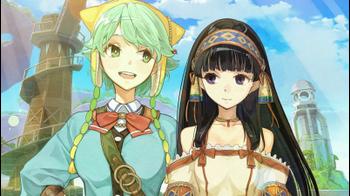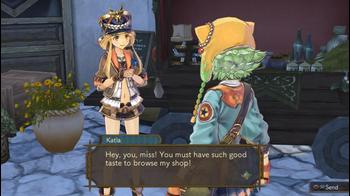
Atelier Shallie: Alchemists of the Dusk Sea Review
Atelier Escha & Logy tried to mix things up by introducing a main male protagonist. Gust soon learned how much that ended up displeasing fans based on the lower sales numbers.
Atelier Shallie: Alchemists of the Dusk Sea looks to remedy that by having two female leads in Shallistera and Shallotte (who share the common “Shallie” nickname to others, but Stera and Lotte to each other) that acts to split the storyline in a similar fashion.
After a short introduction of both ladies, players are given a choice between the pair to experience the events of the story through their eyes. Set six years after the events of Escha & Logy, things are looking more destitute than ever as the Dusk, a natural phenomenon of desertification, has really taken its toll on the world.
Looking to save her village, clan heir Shallistera heads out to find a solution before they are wiped out. She soon meets the tomboy Shallotte who is still trying to find her main goal in life.
Though each heroine's story is unique in many respects, changing up the people you will meet and the personal events that they will encounter, many of the moments are told with both parties present. Lotte also seems to be tailored towards those who are more used to the series, with plenty of references to past titles, while Stera is meant for newcomers.
Though the idea seems novel, there aren’t that many moments during the game where the two aren’t seen together. Thankfully, Stera and Lotte are so well developed that it still warrants playing the game a second time. The writers also did a good job in fleshing out the rest of the cast to make them seem like they belong there. There are a handful of returning characters, but there are also some notable absences including Logy and Ayesha.
Although Atelier Shallie acts as the finale in the Dusk trilogy. a lot of key matters go unresolved. While the game tries to tie up any loose ends, most of it are told through muted encounters. Even the crucial plot point of how the Dust came about and how to recover from it is left on an awkward note.
We aren’t even clearly told how alchemy played a role in nature’s downfall, leaving us with more questions than answers. If this is the end of a trilogy, it sure didn’t seem like it as the tone is kept light-hearted and slice-of-life almost throughout, save for the somber opening movie. All sense of gravitas is lost by the time the game is over.
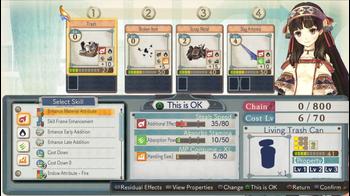
The alchemy system has gotten a nice upgrade this time around, though the basic mechanics of item synthesis remain the same: learn new recipes from books; collect materials from different gathering spots outside town or from enemies; and expand on created items to make even better ones.
In addition, a wide selection of new modifiers and skills are thrown in, providing many more ways to improve the effects of an item, with new abilities being unlocked as the player’s alchemy level increases.
Combat has also been streamlined. While I still contend that Atelier Escha & Logy has the best battle system in years, Shallie does a few things new with the same template. While the same layout remains the same, with three party members in the front and three waiting in the wings, players no longer have to wait for a single Support bar to be filled to swap another character in.
Instead, each individual person has their own separate bar that fills up, allowing plenty of opportunities of chain attacks or a quick retreat for someone on the verge of death. This means less mechanics to pay attention to and more time spent enjoying the battles themselves.
Perhaps the biggest addition is the Burst feature. Once a bar at the top of the screen fills up, not only does the damage output increase, but players also have the chance of activating a Field Burst that triggers a certain member’s unique special ability that affects the party. These range from being able to recover both HP and MP while waiting in reserve to becoming immune towards most forms of damage.
While this makes it seem like combat is a walk in the park, there’s a constant tug-of-war going on notably during boss battles where the enemy can knock that bar back down if they land successful attacks. This brings plenty of intense and frenetic battles, especially on the harder difficulty levels.
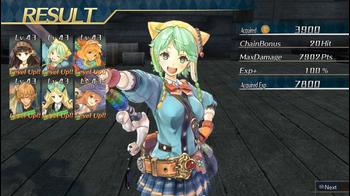
Visually, the game has never looked better, with player models closely resembling their concept art to an almost impeccable level of detail. Characters also express a wider range of emotion in their animation, and the world looks as beautiful as the series has ever been.
However, there were some cases where the framerate dropped and a loading screen appearing even during combat. Despite this, the presentation quality remains high.
The music is equally amazing with some fantastic tunes to take in and fall in love with. I did notice a few cases of unusual choices in music in some of the more important story scenes, like having the upbeat sound of trumpets play directly following an emotional encounter. While the Gust sound team turned in another great performance, it felt like there was little in terms of variety, with plenty of tracks being recycled throughout the game.
The voice acting on the other hand is pretty darn good, both with the Japanese and English voice cast. I couldn't point out any performance that didn't at least hit their mark, especially Jurie's English voice. There is some really recognizable talent on the Japanese side as well, like how Lotte is voiced by the same person who did Dekomori from the anime Chuunibyou.The English side still has the problem of having several unvoiced scenes, but I've come to accept that as the norm in this genre.
The one thing the Atelier series is most known for aside from its alchemy system are its time-management mechanics. Players would have to adhere to a strict schedule, being forced to complete any main story objectives and side quests before their “time” is up for the chapter.
Atelier Shallie bucks the trend by doing away with the whole system, instead allowing people all the time in the world to do anything they want before advancing the game. By removing all sense of tension and urgency from the series, the game loses in my opinion its sense of differentiation.
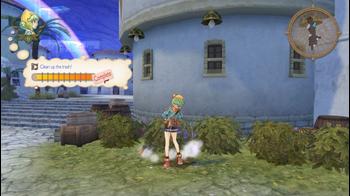
This single feature has been the source of apprehension from outsiders who don’t care for those sorts of constraints that act to hinder their time with an RPG. Things come down to the type of player you are and whether you can put up with the changes.
It’s not really a knock against the game as its meant to open the series to newcomers, but this is an odd time to go against the grain, especially at the end of a trilogy.
The main focal point of the game are Life Tasks. These range from plot objectives to a random assortment of MMO-style fetch quests and quantitative goals, including “Gather X number” of materials or “Synthesize X number” of items.
They are mostly arbitrary, though there is a near-endless amount of them, including party member-specific quests usually prompted from cutscenes in town. They all net a decent amount of experience earned in the next combat encounter and is evidently the fastest way to progress in the game.
After last year’s Ar nosurge mess, I hoped that was a one-off with the problems in the localization, namely the slew of typos, incorrect dialog placement, and confusing descriptions. Sad to say, those same problems carry over to Atelier Shallie. There were many cases of text errors, to the point where it seemed like entire lines were either missing or they ended up being jumbled together.
Here, let me read you the copy verbatim from the quest “Purchased items worth 50,000 Cole!” - “Did I spend too much money? It’s bothersome to gather ingredients, so Want to buy things like water for Synthesis, but I could always draw water at the fountain to save money.”
Now, I recently learned that the name of the quest is supposed to be what you did to trigger the new one described in the summary above. Even then, that doesn’t forgive the rest of the text. This also has a nasty effect during gameplay. Every time you are working your way through a specific task, a progress bar appears on screen to signify how close you are to accomplishing the goal.
This is where it got confusing with how the game presented those same bars. By breaking a barrel, I bought an item. By jumping, I defeated an enemy. By defeating an enemy, I increased my Jump bar.
They're not all like this, but I found examples of translation errors in every single chapter, like how the text at the end of a piece of dialog tells you to “Send” by pressing a button. It’s the very definition of a rush job, and it works to break the immersion.
To be fair, I don’t know how much of it is on the Japanese side. Gust have a bit of a reputation of being a little sloppy when presenting their different systems.
When the Life Tasks play such an important role in the game, though, more time should have been spent in making sure the descriptions made sense to the player.
That’s not to say I didn’t have a great time with Atelier Shallie. The gameplay is as fun as ever, the characters are very likeable, everything looks beautiful, and the alchemy system is more dangerously addictive. I sincerely loved my time with it.
By introducing new systems such as the Life Tasks and the Burst meter that give the party perks in battle, everything works to compliment existing mechanics.
While there will be people who feel differently about the questionable removal of a rigid time structure, it is an important step towards making the series more approachable to a wider audience. Now they just need to work on the localization.
